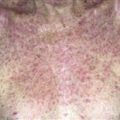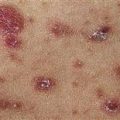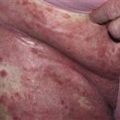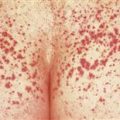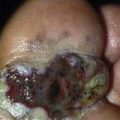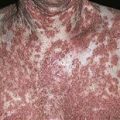108
Sun-damaged
skin, photoaging
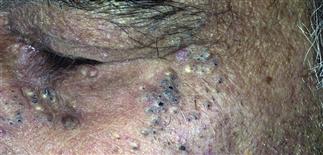
Degraded collagen cannot support hair follicles. The follicles expand, accumulate sebum, and form comedones.
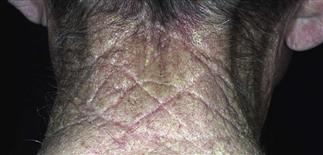
Sun-induced wrinkling on the back of the neck shows a series of criss-crossed lines.
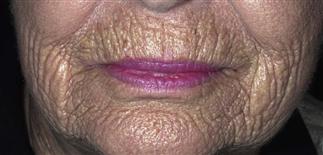
Course wrinkling occurs following loss of elastic tissue and collagen. The skin surface is firm, smooth, and yellow.
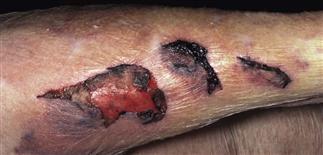
Bleeding occurs with the slightest trauma to sun-damaged surfaces of the forearms and hands. The fragile skin tears easily.
DESCRIPTION
Recognizable, morphologic changes in the skin resulting from years of accumulated ultraviolet radiation.
HISTORY
• No known innate gender difference in susceptibility. Persons with fair complexion (skin types 1 and 2) at greatest risk. • Signs of photoaging apparent by age 40. Progressive damage from years of sun exposure continues. • Some actinic keratoses may regress completely with sun protection and time.
PHYSICAL FINDINGS
• Skin appears older than its chronologic age, with all skin components affected. • Face, lateral neck, and dorsal hands more severely affected. Posterior neck is also involved in male patients. • Poikiloderma describes the combination of epidermal atrophy, hyperpigmentation and hypopigmentation, and telangiectasia. • Skin appears loose and without resilience. Epidermis is thinned and dry. Pigmentation is uneven and blotchy with lentigines. Fine wrinkles lateral to the eyes and deep furrows form on forehead, at angles of mouth, and on posterior neck. Telangiectatic blood vessels appear on ears and lateral cheeks. Pilosebaceous units are prominent and dilated with retained keratin (solar comedones), especially lateral to the eyes. • The skin of the dorsal hands and forearms bruises with minimal trauma (solar purpura). • Skin beneath the chin is unaffected.
TREATMENT
• Sun-protective clothing and regular use of sunscreens slows the progression of solar damage. Sun-protective measures alone improve photoaging, prevent further damage, and reduce skin cancer risk. • Topical retinoids such as tretinoin (Renova 0.01%, 0.05%) and tazarotene 0.1% (Tazorac) reverse some photoaging over several months. Epidermal hyperkeratosis decreases, pigmentation becomes more uniform and lighter, and new collagen is deposited within the papillary dermis. Improvement is dose-dependent and persists as long as the retinoid is continued. • Various peeling agents can also improve texture and appearance of sun-damaged skin. Alpha-hydroxy acids reduce hyperkeratosis, promote epidermal thickening and new collagen formation in papillary dermis. Beta-hydroxy acids improve solar comedones and epidermal texture. • Deeper peeling agents such as trichloroacetic acid and phenol cause full-thickness epidermal damage with intentional wounding of papillary dermis. Wounding causes a thin zone of scar formation (new collagen) in papillary dermis, effectively reducing wrinkles. • Laser resurfacing has a similar effect on papillary dermis.

